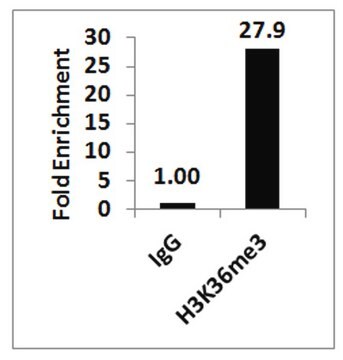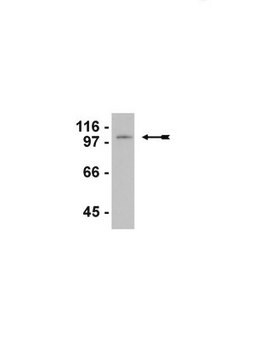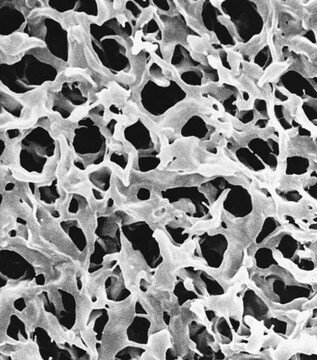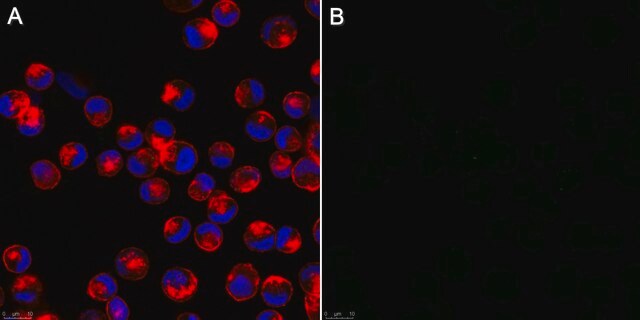17-10531
ChIPAb+ LSD1 (KDM1A) Antibody - ChIP Validated Antibody and Primer Set
from rabbit, purified by affinity chromatography
Synonyme(s) :
Lysine-specific histone demethylase 1A, BRAF35-HDAC complex protein BHC110, Flavin-containing amine oxidase domain-containing protein 2
About This Item
Produits recommandés
Source biologique
rabbit
Niveau de qualité
Clone
polyclonal
Produit purifié par
affinity chromatography
Espèces réactives
rat, human, mouse
Fabricant/nom de marque
ChIPAb+
Upstate®
Technique(s)
ChIP: suitable
immunoprecipitation (IP): suitable
western blot: suitable
Numéro d'accès NCBI
Numéro d'accès UniProt
Conditions d'expédition
dry ice
Description générale
The ChIPAb+ LSD1 (KDM1A) set includes a LSD1 antibody, a Normal rabbit IgG and positive control primers which amplify a 85bp human prostate-specific antigen enhancer region. The LSD1 antibody and negative control IgG are supplied in a scalable "per ChIP" reaction size and can be used to functionally validate the precipitation of LSD1 associated chromatin.
Immunogène
Application
Sonicated chromatin prepared from hormone starved (72 hrs), then androgen agonist induced (1 µM CI-4AS-1 overnight) LNCaP cells (~1e5 cell equivalents per IP) were subjected to chromatin immunoprecipitation using 2 µg of either Normal Rabbit IgG (Part No. PP64B), or 2 µg Anti-LSD1 (Part No.CS207350) and the Magna ChIP HiSens (Cat. # 17-10460). Successful immunoprecipitation of LSD1 associated DNA fragments was verified by qPCR using ChIP Primers, PSA (Part No. CS207340) as a positive locus, and ChIP Primers, β-globin (Part No. CS200591) as a negative locus.
Please refer to the Magna ChIP HiSens (Cat. # 17-10460) or EZ-Magna ChIP HiSens(Cat. # 17-10461) protocol for experimental details.
Chromatin Immunoprecipitation:
Sonicated chromatin prepared from hormone starved (72 hrs), then androgen agonist induced (1 µM CI-4AS-1 overnight) LNCaP cells (1e5 and 1e6 cell equivalents per IP) were subjected to chromatin immunoprecipitation using 2 µg of either Normal Rabbit IgG (Part No. PP64B), or 2 µg Anti-LSD1 (Part No. CS207350) and the Magna ChIP HiSens Kit (Cat. # 17-10460). Successful immunoprecipitation of LSD1 associated DNA fragments was verified by qPCR using ChIP Primers, PSA (Part No. CS207340).
Please refer to the Magna ChIP HiSens (Cat. # 17-10460) or EZ-MagnaChIP HiSens (Cat. # 17-10461) protocol for experimental details
Western Blotting Analysis:
HeLa nuclear extract was probed with Anti-LSD1 (0.05 μg/mL).
Proteins were visualized using a Donkey Anti-Rabbit IgG secondary antibody conjugated to HRP and a chemiluminescence detection system.
Epigenetics & Nuclear Function
Histones
Conditionnement
Qualité
Please refer to the MagnaChIP HiSens (Cat. # 17-10460) or EZ-MagnaChIP HiSens (Cat. # 17-10461) protocol for experimental details.
Description de la cible
Forme physique
Normal rabbit IgG, Part No. PP64B. One vial containing 125 µg Rabbit IgG in 125 µL storage buffer containing 0.05% sodium azide. Store at -20°C.
ChIP Primers, PSA. Part No. CS207340. One vial containing 75 μL of 5 μM of each primer specific for human prostate-specific antigen (PSA) enhancer region (chr19:51354179-51354263, hg19 build). Store at -20°C.
FOR: GCC TGG ATC TGA GAG AGA TAT CAT C
REV: ACA CCT TTT TTT TTC TGG ATT GTT G
Stockage et stabilité
Remarque sur l'analyse
Includes normal rabbit IgG and primers specific for a human prostate-specific antigen (PSA) enhancer region.
Autres remarques
Informations légales
Clause de non-responsabilité
Code de la classe de stockage
10 - Combustible liquids
Certificats d'analyse (COA)
Recherchez un Certificats d'analyse (COA) en saisissant le numéro de lot du produit. Les numéros de lot figurent sur l'étiquette du produit après les mots "Lot" ou "Batch".
Déjà en possession de ce produit ?
Retrouvez la documentation relative aux produits que vous avez récemment achetés dans la Bibliothèque de documents.
Notre équipe de scientifiques dispose d'une expérience dans tous les secteurs de la recherche, notamment en sciences de la vie, science des matériaux, synthèse chimique, chromatographie, analyse et dans de nombreux autres domaines..
Contacter notre Service technique





